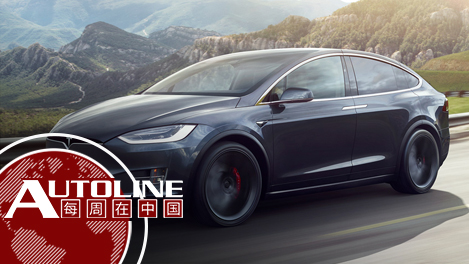
[autolinedaily show=”DailyChina013019″]
运行: 6:18
观看此节目在优酷,请点击这里
– 宝马加快3D打印零件的使用
– 超级电容器驱动的商用车辆
– 博格华纳创造集成电动车动力系统
– 沃尔沃采用无人驾驶技术开采石灰石
– TESLA占领了电动车辆的领域
请访问我们的赞助商,感谢他们的支持自动线的中国: ExxonMobil
大家好,我是约翰•麦克罗伊,欢迎收看Autoline中国,我们的节目将为您呈现汽车领域最重要最前沿的行业新技术。
宝马加快3D打印零件的使用
宝马正在加快生产车辆中3D打印组件的使用。在过去的十年中,它使用该技术制造生产了一百万个零件。2018年,该公司生产了200,000个零部件,比去年增长了42%。 虽然它们大多是小部件,如i8中的这种窗口导轨,但3D组件确实提供了一些好处。对于客户来说,它可以让他们更加个性化,也可以让宝马更快地开发零件,在某些情况下,可以使零件更轻,更坚固。
超级电容器驱动的商用车辆
总部设在新加坡的物流公司可能是第一家使用具有超级电容器的商用电动车,而不仅仅是电池。 这家物流公司名为Avevai,超级电容器由一家名为e-Synergy的公司生产,该公司也位于新加坡。 超级电容器注入石墨烯,据说比仅依靠电池的轻型商用车提供多40%的里程范围。超级电容器可以比电池更快地充电和放电,但通常缺乏能量密度。Avevai称它有一辆电动卡车,可提供298公里的续航里程,并在2小时内使用III级快速充电器充满。它声称电池可以在高达65摄氏度,低至40摄氏度以下的环境温度下持续有效运行。
接下来…… 沃尔沃卡车使用自动卡车来帮助开采石灰石。
博格华纳创造集成电动车动力系统
汽车供应商正全面投身电动汽车领域。这也是我们看到如此多的电动汽车创业公司的原因之一。他们可以从供应商那里购买电动车动力系统。博格华纳提出了一个称为集成驱动模块的光滑单元。它将电动机,电力电子设备和变速器集成到一个模块中。事实上,电力电子设备在一个外壳中,其实可以兼作模块的受压构件。通过集成电力电子和电动机,消除了一组冷却软管,并大大减少了高压橙色电缆的数量。通过将变速器组合到模块中,博格华纳公司推出了一种电动汽车动力单元,它比仅采用单独单元并将它们连接在一起的动力单元更硬更轻。
沃尔沃采用无人驾驶技术开采石灰石
我们向您展示了沃尔沃卡车的自动化技术有助于完成收获甘蔗和收集垃圾等任务。现在,该公司正在展示其自动驾驶技术如何用于采矿。它与挪威的Bronnoy Kalk合作,将石灰石沿着5公里的路线从矿山运输破碎机,然后再进行转运。正在用于使用的沃尔沃FH卡车共有六辆,但采矿公司并不拥有卡车,而是购买从一个中转站到另一个中转站的运输服务,支付每公吨石灰石的运送量。沃尔沃卡车负责运输石灰石,目前这只是一个测试,但到明年年底它将全面运作。
接下来……中国消费者会更喜欢电动汽车还是插电式混合动力汽车?也许从美国市场可以吸取教训。
TESLA占领了电动车辆的领域
11月份美国电动汽车销量增长了惊人的176%。这都是由于特斯拉的销售增长。如果将特斯拉排除在外,电动汽车的销量下降了约58%。
有趣的是,电动汽车的销量远远高于插电式混合动力车的销量,尽管展厅中只有12款电动汽车车型 – 主要是在加利福尼亚州,而在更多州销售的插电式混合动力车型却有23种。行业专家曾预估,消费者会处于对行驶里程的担忧,而更喜欢插电式混合动力车。然而事实并非如此。
但这是由于特斯拉品牌效应而扭曲的数字。其实这并不表明消费者更喜欢电动汽车而不是插电式混合动力车,而是他们喜欢特斯拉的品牌胜过其他所有东西。看看中国的汽车购买者是更喜欢电动汽车,还是插电式混合动力汽车呢?这将会很有趣。
本期Autoline中国的报道到这里就结束了。感谢您的收看。
Hello, I’m John McElroy, welcome to Autoline China, the show that covers some of the most important new technologies in the automotive industry.
BMW RAMPS UP USE OF 3D PRINTED PARTS
BMW is ramping up the use of 3D printed components in production vehicles. Over the last decade, its produced a million parts using additive manufacturing. In 2018, the company made 200,000 components, which is up 42% from last year. While they’re mostly small parts, like this window guide rail in the i8, the 3D components do provide some benefits. For customers, it allows them more personalization and for BMW It allows it to develop parts more quickly and in some cases, make them lighter and stronger.
COMMERCIAL VEHICLES POWERED BY SUPERCAPACITORS
A logistics company based in Singapore may be the first to use commercial electric vehicles that have supercapacitors, not just batteries. The logistics company is called Avevai and the supercapacitors are made by a company called e-Synergy, which is also based in Singapore. The supercapacitors are infused with graphene and are said to provide 40% greater range than light commercial vehicles that rely solely on batteries. Supercapacitors can charge and discharge electricity far faster than batteries, but have typically lacked in energy density. Avevai says it has an electric truck that offers a 298-kilometer range and can be recharged in 2 hours with a Level III fast charger. And it claims the batteries can operate efficiently in ambient temperatures as high as 65 degrees Celsius all the way down to 40 below.
Still to come…Volvo Trucks uses autonomous trucks to help mine limestone.
BORGWARNER CREATES INTEGRATED EV POWERTRAIN
Automotive suppliers are jumping into the EV segment with both feet. It’s one of the reasons why we’re seeing so many EV startups. They can buy EV powertrains from suppliers. And BorgWarner has come up with a slick unit it calls the Integrated Drive Module. It integrates the electric motor, with the power electronics and the transmission into one module. In fact, the power electronics are in a housing that actually doubles as a stressed member of the module. By integrating the power electronics and electric motor, this eliminates a set of cooling hoses, and greatly reduces the number of high-voltage, orange cables. By combining the transmission into the module, BorgWarner has come up with an EV power unit that is stiffer and lighter than those that simply take separate units and bolt them together.
VOLVO MINES LIMESTONE WITH NO DRIVER
We’ve shown you autonomous technology from Volvo Trucks, that is helping with tasks like harvesting sugar cane and collecting garbage. And now the company is demonstrating how its self-driving tech can be used for mining. It’s working with Bronnoy Kalk in Norway to transport limestone along a 5 kilometer route, from the mine to a crusher where it can then be shipped. Six Volvo FH trucks are being used but the mining company doesn’t own the trucks, instead it buys a hub-to-hub transport service and pays per metric ton of limestone delivered. Volvo Trucks is taking responsibility for transporting the limestone. Currently this is just a test but by the end of next year it will be fully operational.
Coming up next…will Chinese consumers prefer battery electric cars, or plug-in hybrids. Maybe there are lessons to be learned from the American market.
TESLA DOMINATES ELECTRIC VEHICLE SEGMENT
Sales of electric cars were up a staggering 176% in the US in November. But Tesla gets all the credit. Take Tesla out of the equation and EV sales were down about 58%.
Interestingly, sales of EVs are much higher than sales of plug-in hybrids, even though there are only 12 EV models in showrooms–mainly in California, while there are 23 models of plug-in hybrids sold in more states. Industry experts thought that consumers would prefer plug-ins over EVs because of range anxiety. That’s not the way it turned out.
But it’s Tesla skewing the numbers. It’s not so much that consumers prefer electrics over plug-ins, it’s that they simply prefer Tesla’s over everything else. And it will be interesting to see if car buyers in China prefer battery electric cars over plug-in hybrids.
And that brings us to the end of this report. Thanks for watching.

John McElroy is an influential thought leader in the automotive industry. He is a journalist, lecturer, commentator and entrepreneur. He created “Autoline Daily,” the first industry webcast of industry news and analysis.




